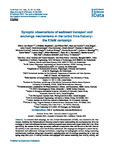Synoptic observations of sediment transport and exchange mechanisms in the turbid Ems Estuary: the EDoM campaign
| dc.contributor.author | van Maren, DS | |
| dc.contributor.author | Maushake, C | |
| dc.contributor.author | Mol, J-W | |
| dc.contributor.author | van Keulen, D | |
| dc.contributor.author | Jürges, J | |
| dc.contributor.author | Vroom, J | |
| dc.contributor.author | Schuttelaars, H | |
| dc.contributor.author | Gerkema, T | |
| dc.contributor.author | Schulz, K | |
| dc.contributor.author | Badewien, TH | |
| dc.contributor.author | Gerriets, M | |
| dc.contributor.author | Engels, A | |
| dc.contributor.author | Wurpts, A | |
| dc.contributor.author | Oberrecht, D | |
| dc.contributor.author | Manning, Andrew | |
| dc.contributor.author | Bailey, T | |
| dc.contributor.author | Ross, L | |
| dc.contributor.author | Mohrholz, V | |
| dc.contributor.author | Horemans, DML | |
| dc.contributor.author | Becker, M | |
| dc.contributor.author | Post, D | |
| dc.contributor.author | Schmidt, C | |
| dc.contributor.author | Dankers, PJT | |
| dc.date.accessioned | 2023-02-14T11:06:00Z | |
| dc.date.available | 2023-02-14T11:06:00Z | |
| dc.date.issued | 2023-01-03 | |
| dc.identifier.issn | 1866-3508 | |
| dc.identifier.issn | 1866-3516 | |
| dc.identifier.uri | http://hdl.handle.net/10026.1/20336 | |
| dc.description.abstract |
<jats:p>Abstract. An extensive field campaign, the Ems-Dollard Measurements (EDoM), was executed in the Ems Estuary, bordering the Netherlands and Germany, aimed at better understanding the mechanisms that drive the exchange of water and sediments between a relatively exposed outer estuary and a hyper-turbid tidal river. More specifically, the reasons for the large up-estuary sediment accumulation rates and the role of the tidal river on the turbidity in the outer estuary were insufficiently understood. The campaign was designed to unravel the hydrodynamic and sedimentary exchange mechanisms, comprising two hydrographic surveys during contrasting environmental conditions using eight concurrently operating ships and 10 moorings measuring for at least one spring–neap tidal cycle. All survey locations were equipped with sensors measuring flow velocity, salinity, and turbidity (and with stationary ship surveys taking water samples), while some of the survey ships also measured turbulence and sediment settling properties. These observations have provided important new insights into horizontal sediment fluxes and density-driven exchange flows, both laterally and longitudinally. An integral analysis of these observations suggests that large-scale residual transport is surprisingly similar during periods of high and low discharge, with higher river discharge resulting in both higher seaward-directed fluxes near the surface and landward-directed fluxes near the bed. Sediment exchange seems to be strongly influenced by a previously undocumented lateral circulation cell driving residual transport. Vertical density-driven flows in the outer estuary are influenced by variations in river discharge, with a near-bed landward flow being most pronounced in the days following a period with elevated river discharge. The study site is more turbid during winter conditions, when the estuarine turbidity maximum (ETM) is pushed seaward by river flow, resulting in a more pronounced impact of suspended sediments on hydrodynamics. All data collected during the EDoM campaign, but also standard monitoring data (waves, water levels, discharge, turbidity, and salinity) collected by Dutch and German authorities are made publicly available at 4TU Centre for Research Data (https://doi.org/10.4121/c.6056564.v3; van Maren et al., 2022). </jats:p> | |
| dc.format.extent | 53-73 | |
| dc.language | en | |
| dc.language.iso | en | |
| dc.publisher | Copernicus GmbH | |
| dc.title | Synoptic observations of sediment transport and exchange mechanisms in the turbid Ems Estuary: the EDoM campaign | |
| dc.type | journal-article | |
| dc.type | Journal | |
| plymouth.author-url | https://www.webofscience.com/api/gateway?GWVersion=2&SrcApp=PARTNER_APP&SrcAuth=LinksAMR&KeyUT=WOS:000906757700001&DestLinkType=FullRecord&DestApp=ALL_WOS&UsrCustomerID=11bb513d99f797142bcfeffcc58ea008 | |
| plymouth.issue | 1 | |
| plymouth.volume | 15 | |
| plymouth.publication-status | Published online | |
| plymouth.journal | Earth System Science Data | |
| dc.identifier.doi | 10.5194/essd-15-53-2023 | |
| plymouth.organisational-group | /Plymouth | |
| plymouth.organisational-group | /Plymouth/Faculty of Science and Engineering | |
| plymouth.organisational-group | /Plymouth/Faculty of Science and Engineering/School of Biological and Marine Sciences | |
| plymouth.organisational-group | /Plymouth/REF 2021 Researchers by UoA | |
| plymouth.organisational-group | /Plymouth/REF 2021 Researchers by UoA/UoA07 Earth Systems and Environmental Sciences | |
| plymouth.organisational-group | /Plymouth/Research Groups | |
| plymouth.organisational-group | /Plymouth/Research Groups/Marine Institute | |
| plymouth.organisational-group | /Plymouth/Users by role | |
| plymouth.organisational-group | /Plymouth/Users by role/Academics | |
| dcterms.dateAccepted | 2022-12-06 | |
| dc.rights.embargodate | 2023-2-15 | |
| dc.identifier.eissn | 1866-3516 | |
| dc.rights.embargoperiod | Not known | |
| rioxxterms.versionofrecord | 10.5194/essd-15-53-2023 | |
| rioxxterms.licenseref.uri | http://www.rioxx.net/licenses/all-rights-reserved | |
| rioxxterms.type | Journal Article/Review |


